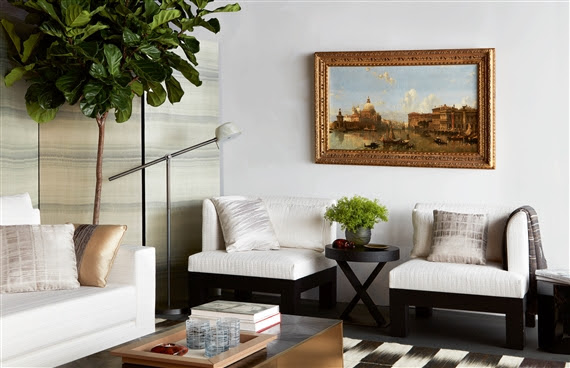David Roberts, R.A. (1796-1864), Venice, Approach to the Grand Canal, 1855, oil on canvas, 25 1/2 by 45 1/2 in. (64.8 by 115.6 cm.) Sold for $300,000 at Sotheby's. On display in a modern home as part of Pollack's collaboration with Victoria Hagan.
"Contemporary works tend to be larger; it's common to see them hung as individual statement pieces, and have space left around them to breathe," says Pollack. "Old Masters, on the other hand, were traditionally hung 'Salon Style' — an approach that saw entire walls covered with artworks hung on top of each other." Though traditional, Pollack admits this type of hang only suits certain spaces: "I find it can get a bit heavy and confusing if you don't have high ceilings and large walls. That said, I do love the warm, intentionally disheveled look of an asymmetrical gallery hang of smaller works like drawings, prints and oil sketches."
4. Do I need to take extra care when hanging an older work?
When displaying an older artwork, it's important to consider the materials the artist used, and work to create an environment that preserves them. "Pieces on wood panel present some of the most common concern," says Pollack, explaining that minute fluctuations in a room's humidity can leave the wood vulnerable to warping. "Generally this isn't a problem though, and can be avoided simply by keeping a consistent climate in the home via normal air conditioning."
Finding the correct frame can also help preserve particularly delicate works, allowing you to create an artificial microclimate that ensures the artwork remains in good health. Our expert guide to framing offers some key tips for those eager to protect treasured pieces.
5. Can I hang different styles and periods together?
"Personally, I believe bleding old and new is the best way to collect, decorate and live," says Pollack. "The age of collecting in one very narrow field has been waning for some time, and the most interesting homes are a reflection of the collector’s individual and myriad tastes, through various centuries and styles."
Far from diminishing the impact of individual works, mixing genres in this way can be highly effective: "Amazing connections can be made by hanging seemingly unrelated works together. I have seen Early Netherlandish portraits hung next to video art, and the outcome was incredible," Pollack adds.
Nicolas Lancret (1690-1743), Winter, oil on canvas, 45 1/4 by 37 in. (115 by 94 cm.), Sold for $2,655,000 at Sotheby's. On display in a modern home as part of Pollack's collaboration with Victoria Hagan.
6. Do older paintings require traditional frames?
As an Old Master paintings specialist, Pollack is perfectly placed to advise on how older works should be displayed: "In certain cases, a traditional or 'old fashioned' frame can look surprisingly modern. Dutch 17th century frames, for example, are traditionally jet black and very simply carved. I love them, and think they compliment most paintings well. Traditional gilt frames can also work well in a modern home, though elobaretly carved frames, which are often 18th century and French, are grand statement pieces and should be used deliberately."
7. Should I consider working with an interior designer?

Sir Anthony van Dyck (1599-1641), Portrait of an Italian Nobleman, oil on canvas, 47 1/4 by 35 in. (120 by 89 cm.), Sold for $975,000 at Sotheby's. On display in a modern home as part of Pollack's collaboration with Victoria Hagan.
"The advice and guidance of a designer can be a great aid, especially on larger projects," says Pollack, who helped lead Sotheby's recent collaboration with celebrated interior designer Victoria Hagan, which showcased ways of incorporating Master paintings into a modern home.
"It really depends on your budget, levels of patience, and trust in your own taste. At the end of the day you are the one living with your objects, and should be the driving force behind how they are displayed."
9. How important is conservation when it comes to hanging?
"Conservation is a big part of responsible hanging," Pollack advises, adding that it's especially important to consider factors including light exposure, which can damage works on paper. "Pastels and other non-oil based work are quite susceptible to over-lighting so one must be careful. Oil paintings are more resilient to direct sunlight."
10. ... and one golden rule?
"In general," finished Pollack, "quality looks good next to quality; a great object can usually hold its own in a domestic setting no matter what."



